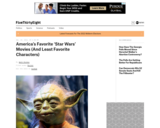
An article based on data and evidence that includes charts and infomation that could be analyzed by students.
- Subject:
- Mathematics
- Material Type:
- Data Set
- Provider:
- FiveThirtyEight
- Date Added:
- 10/24/2022

An article based on data and evidence that includes charts and infomation that could be analyzed by students.

Students use pantomime and role-playing to understand the roles in ancient Egypt

Learn about different animal adaptations while playing theater games.

In this demonstration, amaze learners by performing simple tricks using mirrors. These tricks take advantage of how a mirror can reflect your right side so it appears to be your left side. To make the effect more dramatic, cover the mirror with a cloth, climb onto the table, straddle the mirror, and then drop the cloth as you appear to "take off." This resource contains information about how this trick was applied during the making of the movie "Star Wars."

P‡ginas 2-3 of Escribiendo Obras Con Los J—venes de Julie Jensen le’do por Isabella Reeder

Students will create square designs using area and perimeter knowledge.

This resource is for high school art teachers to virtually connect their students with arts professionals. Jewelry artist and arts professional Jennifer Ortiz shows us her studio and talks to us about working as an artist part-time, using the artistic process to learn and experiment, reusing and recycling materials, and finding your niche as an artist by making art you love!
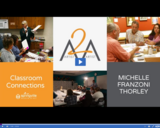
This resource is for high school art teachers to virtually connect their students with arts professionals. Join professional artist Michelle Franzoni Thorley as she discusses her artistic process and inspiration. She covers topics like the importance of representation in art, the power of art to heal, and gives advice to high school students on how to pursue an art career.
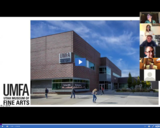
A 2-hour webinar describing the resources available from the Utah Museum of Fine Arts for your in-person or online classroom.
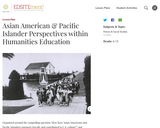
Organized around the compelling question "How have Asian Americans and Pacific Islanders engaged civically and contributed to U.S. culture?" and grounded in inquiry-based teaching and learning, this lesson brings history, civics, and the arts together to learn about the experiences and perspectives of Asian Americans and Pacific Islanders (AAPI) in U.S. history. elementary sources, literature, and works of art created by AAPI individuals and related organizations provide an historical as well as contemporary context for concepts and issues including civic participation, immigration, and culture.
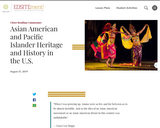
The month of May is an opportunity for reflection on and commemoration of all that AAPI individuals and organizations have accomplished and contributed to U.S. history and culture. This piece highlights NEH projects and classroom resources for teaching about these experiences in America.

Sharah Meservy teaches students how to make origami finger puppets.

In this episode of UEN's PDTV, preservice teachers Aniston and Mallory reflect on their first professional conference at the Utah Coalition for Educational Technology (UCET) annual event. They’ll share their top ten tips for conference preparation, and through their insights, you’ll learn how to maximize your next professional conference experience.

Page 10 of Playwriting with Young People by Julie Jensen read by Kallie Fillanda.
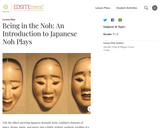
Noh, the oldest surviving Japanese dramatic form, combines elements of dance, drama, music, and poetry into a highly stylized, aesthetic retelling of a well-known story from Japanese literature, such as The Tale of Genji or The Tale of the Heike. This lesson provides an introduction to the elements of Noh plays and to the text of two plays, and provides opportunities for students to compare the conventions of the Noh play with other dramatic forms with which they may already be familiar, such as the ancient Greek dramas of Sophocles. By reading classic examples of Noh plays, such as Atsumori, students will learn to identify the structure, characters, style, and stories typical to this form of drama. Students will expand their grasp of these conventions by using them to write the introduction to a Noh play of their own.
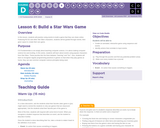
In this lesson, students will practice using events to build a game that they can share online. Featuring R2-D2 and other Star Wars characters, students will be guided through events, then given space to create their own game.
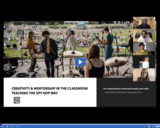
Three examples of the hour-long 'Teachng The Spy Hop Way' teacher training, where Myke Johnson takes participants through the different philosophies of creative design and youth engagement. These techniques foster youth voice and empowerment, as well as creating a safe space for artistic exploration. Some of these tools include listening techniques, inquiry based learning structures and quick, fun activities that transform a classroom into a hands-on artistic learning environment.

Integrating Visual Art and Math

In this episode of UEN's PDTV, we explore strategies to discover high-quality digital resources aligned with Utah Core Standards beyond basic Google searches and expensive educational websites. Join host Katie Blunt as she chats with Lindsey Henderson, a Mathematics Specialist with the Utah State Board of Education, and Jennifer Burt, a Mathematics teacher at Syracuse Jr. High, to learn effective strategies for finding, organizing and curating the perfect digital resources for your students using UEN’s eMedia platform.

Students will learn the potential costs and benefits of social media, digital consumption, and our relationship with technology as a society in the three-week lesson. This inquiry based unit of study will answer the following questions:
Essential Question: How can we use science fiction’s ability to predict the future to help humanity?
Supportive Questions 1: What predictions of future development has science fiction accurately made in the past? This can include technology, privacy, medicine, social justice, political, environmental, education, and economic.
Supportive Question 2: What predictions for future development in contemporary science fiction are positive for the future of humanity? What factors need to begin in your lifetime to make these predictions reality?
Supportive Question 3: What predictions for future development in contemporary science fiction are negative for the future of humanity? What factors need to begin in your lifetime to stop these negative outcomes?
(Thumbnail is a screenshot of the OER Commons lesson page, taken 7/26/2022 by Christina Nelson.)